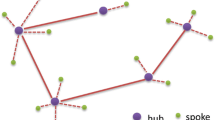Abstract
Commercial ports require an efficient means of scheduling vessels for public berths. In this study, a wharf-based genetic algorithm is proposed for the scheduling of public berths with the aim of reducing reliance on communications and shortening the waiting time of vessels. Schedules are initially encoded as chromosomes, based on wharf characteristics and the need from the generated wharf matching lists to avoid assigning vessels to inappropriate wharves. The proposed algorithm uses a special wharf-based sequential type of chromosome that keeps all of the generated schedules as feasible solutions. Following the selection process, crossover, and mutation, the proposed algorithm adjusts the usage of wharves in order to increase the speed of convergence. The proposed algorithm is able to handle a greater number of vessels when combined with the map-reduce technique. Experimental results demonstrate the effectiveness of the proposed algorithm at assigning vessels to appropriate berths as soon as they arrive. Compared to three other existing algorithms, it performs nine times faster in terms of convergence speed and produces better quality of the solutions.
















Similar content being viewed by others
References
Boile M, Golias M, Theofanis S (2009) Scheduling of berthing resources at a marine container terminal via the use of genetic algorithms: current and future research. In: dos Santos WP (ed) Evolutionary Computation. InTech. doi:10.5772/9602. ISBN 978-953-307-008-7
Brodersen OB, Meier L, Schumann M (2010) Optimizing the berth allocation problem using a genetic algorithm and particle swarm optimization. Paper presented at the MKWI 2010—Planung/Scheduling und Konfigurieren/Entwerfen
Cheong CY, Lim CJ, Tan KC, Liu DK (2007) A multi-objective evolutionary algorithm for berth allocation in a container port. In: 2007 IEEE Congress on evolutionary computation, 25–28 Sept 2007, pp 927–934. doi:10.1109/CEC.2007.4424569
Eiben AE, Smith JE (2003) Introduction to evolutionary computing. Natural computing series. Springer, New York. doi:10.1007/978-3-662-05094-1
Frojan P, Correcher JF, Alvarez-Valdes R, Koulouris G, Tamarit JM (2015) The continuous berth allocation problem in a container terminal with multiple quays. Expert Syst Appl 42:7356–7366. doi:10.1016/j.eswa.2015.05.018
Gkolias MD (2007) The discrete and continuous berth allocation problem: models and algorithms. Rutgers University, New Jersey. doi:10.7282/T3DB828Q
Goh KS, Lim A (2000) Combining various algorithms to solve the ship berthing problem. In: 12th IEEE international conference on tools with artificial intelligence, 2000. ICTAI 2000. Proceedings. pp 370–375. doi:10.1109/TAI.2000.889896
Guan Y, Cheung RK (2004) The berth allocation problem: models and solution methods. OR Spectr 26:75–92. doi:10.1007/s00291-003-0140-8
Imai A, Nishimura E, Papadimitriou S (2001) The dynamic berth allocation problem for a container port. Transp Res Part B Methodol 35:401–417. doi:10.1016/S0191-2615(99)00057-0
Imai A, Sun X, Nishimura E, Papadimitriou S (2005) Berth allocation in a container port: using a continuous location space approach. Transp Res Part B Methodol 39:199–221. doi:10.1016/j.trb.2004.04.004
Imai A, Zhang JT, Nishimura E, Papadimitriou S (2007) The berth allocation problem with service time and delay time objectives. Marit Econ Logist 9:269–290
Lee HH (2000) Taguchi methods principles and practices of quality design. Gau Lih, New Taipei City
Lee Y, Chen CY (2009) An optimization heuristic for the berth scheduling problem. Eur J Oper Res 196:500–508. doi:10.1016/j.ejor.2008.03.021
Lim A (1998) The berth planning problem. Oper Res Lett 22:105–110. doi:10.1016/S0167-6377(98)00010-8
Ludwig SA (2011) Single-objective versus multi-objective genetic algorithms for workflow composition based on service level agreements. In: 2011 IEEE international conference on service-oriented computing and applications (SOCA), 12–14 Dec 2011. pp 1–8. doi:10.1109/SOCA.2011.6166211
Moorthy R, Teo CP (2006) Berth management in container terminal: the template design problem. OR Spectr 28:495–518. doi:10.1007/s00291-006-0036-5
Nishimura E, Imai A, Papadimitriou S (2001) Berth allocation planning in the public berth system by genetic algorithms. Eur J Oper Res 131:282–292. doi:10.1016/S0377-2217(00)00128-4
Pandian MV (ed) (2013) Meta-heuristics optimization algorithms in engineering, business, economics, and finance. IGI Global, Hershey. doi:10.4018/978-1-4666-2086-5
Pandian MV (ed) (2014) Handbook of research on novel soft computing intelligent algorithms: theory and practical applications, vol 2. IGI Global, Hershey. doi:10.4018/978-1-4666-4450-2
Pandian V (ed) (2015) Handbook of research on artificial intelligence techniques and algorithms, vol 2. IGI Global, Hershey. doi:10.4018/978-1-4666-7258-1
Pandian V, Nadar B, Jeffrey W (eds) (2012) Innovation in power, control, and optimization: emerging energy technologies. IGI Global, Hershey. doi:10.4018/978-1-61350-138-2
Park KT, Kim KH (2002) Berth scheduling for container terminals by using a sub-gradient optimization technique. J Oper Res Soc 53:1054–1062
Park YM, Kim HK (2003) A scheduling method for berth and quay cranes. OR Spectr 25:1–23. doi:10.1007/s00291-002-0109-z
Ting CK, Lee CN, Chang HC, Wu JS (2009) Wireless heterogeneous transmitter placement using multiobjective variable-length genetic algorithm. IEEE Trans Syst Man Cybern Part B (Cybern) 39:945–958. doi:10.1109/TSMCB.2008.2010951
Yan S, Lu CC, Hsieh JH, Lin HC (2015) A network flow model for the dynamic and flexible berth allocation problem. Comput Ind Eng 81:65–77. doi:10.1016/j.cie.2014.12.028
Author information
Authors and Affiliations
Corresponding author
Ethics declarations
Conflict of interest
Authors declare that there is no conflict of interest.
Ethical approval
This article does not contain any studies with human participants or animals performed by any of the authors.
Additional information
Communicated by C.-H. Chen.
Electronic supplementary material
Below is the link to the electronic supplementary material.
Rights and permissions
About this article
Cite this article
Tsai, AH., Lee, CN., Wu, JS. et al. Novel wharf-based genetic algorithm for berth allocation planning. Soft Comput 21, 2897–2910 (2017). https://doi.org/10.1007/s00500-016-2272-1
Published:
Issue Date:
DOI: https://doi.org/10.1007/s00500-016-2272-1




